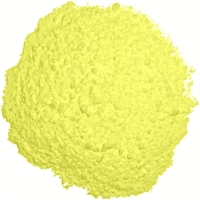Precipitated sulfur
 | |
| Names | |
|---|---|
| Other names | Milk of sulfur;[1] sulfur praecipitatum; sulphur precipitated in petroleum jelly |
| |
| Clinical data | |
| Main uses | Scabies, lice, acne, rosacea, tinea, warts, seborrheic dermatitis[2][1][3] |
| Side effects | smells unpleasant possibility contact dermatitis.[1] |
| Routes of use | Topical, rarely by mouth |
| External links | |
| AHFS/Drugs.com | Multum Consumer Information |
| Legal | |
| Legal status |
|
| Chemical and physical data | |
| Formula | S8 |
| Molar mass | 256.48 g·mol−1 |
| 3D model (JSmol) | |
| |
| |
Precipitated sulfur is used as a medication to treat scabies and lice; including head, body, and pubic lice.[3] Other uses include acne, rosacea, tinea, warts, and seborrheic dermatitis.[2][1] It is applied to the skin.[4]
Side effects include the fact that it smells unpleasant possibility contact dermatitis.[1] Use appears safe during pregnancy and breastfeeding, except around the breast.[5][1] It may be better tolerated than benzoyl peroxide.[1] It acts as a keratolytic agent and also kills bacteria, parasites, and fungi.[2][1] Chemically, it is the naturally occurring octasulfur (S8).[6]
Sulfur has a history of medical use going back to at least the time of Hippocrates.[1] While not officially approved for a specific medical use in the United States, it is avaliable over the counter as of 2020.[2] It is approved for use in Saudi Arabia.[2] It is on the World Health Organization's List of Essential Medicines as an alternative to benzyl benzoate.[4] It may also be compounded by a pharmacy.[7] It is generally not expensive.[8] In medicine it is the most commonly used form of sulfur.[9]
Medical uses
Precipitated sulfur and colloidal sulfur are used, in form of lotions, creams, powders, soaps, and bath additives, for the treatment of acne vulgaris, acne rosacea, and seborrhoeic dermatitis.[10][11][12] Other topical uses included the treatment of superficial mycoses (infections with fungi) and scabies, but this is largely obsolete now.
Dosage
Often uses as 0.5 to 25% applied to the skin.[2] For scabies it is used once per day for 3 days as a 10% preparation.[13]
Side effects
Common side effects include irritation of the skin at the application site, such as dryness, stinging, itching and peeling.[14] Generalised allergic reactions are rare; they include hives as well as swelling of lips, tongue, and throat, potentially closing up the respiratory tract.[14]
Overdose
Ingesting more than a few grams can lead to poisoning by hydrogen sulfide (H2S), which the gut flora produces from sulfur. H2S is also generated on the skin, but topical formulations do not induce toxic concentrations, except when large quantities are used for small children.[10]
Mechanism of action
Sulfur is converted to hydrogen sulfide through reduction, partly by bacteria. H2S kills bacteria (possibly including Propionibacterium acnes which plays a role in acne[11]), fungi, and parasites such as scabies mites. In the gut, H2S increases motility, acting as a laxative.[10] Sulfur's keratolytic action is also mediated by H2S; in this case, the hydrogen sulfide is produced by direct interaction with the target keratinocytes themselves.[15]
Manufacture

- Precipitated sulfur (sulfur praecipitatum) is prepared by boiling sulfur and calcium oxide in water and then precipitating with hydrochloric acid. It, too, is a fine yellow powder.[10]
- Flower of sulfur or sublimed sulfur (Latin: sulfur sublimatum) is the naturally occurring, unpurified form.[10] It comes in yellow flakes and has been used in traditional and alternative medicine, as well as in alchemy and sulfuring fruit before drying.
- Purified sulfur (sulfur depuratum) is prepared by washing sublimed sulfur with ammonia. It is a fine yellow powder. It was formerly used as a laxative, but this application is rare today.[10]
- Colloidal sulfur (sulfur colloidale) is an extremely fine sulfur powder prepared by repeated precipitation, first from polysulfides with protein and then from a slightly alkaline solution with ethanol or acetone. It has a greyish-white colour. Colloidal solutions in water are milky, and bluish when viewed against the light due to the Tyndall effect.[10]
See also
- Sulfur (general information about this chemical element)
References
- ↑ 1.0 1.1 1.2 1.3 1.4 1.5 1.6 1.7 1.8 Wolverton, Stephen E.; Wu, Jashin J. (14 December 2019). Comprehensive Dermatologic Drug Therapy. Elsevier Health Sciences. p. 611. ISBN 978-0-323-61212-8. Archived from the original on 16 December 2023. Retrieved 15 December 2023.
- ↑ 2.0 2.1 2.2 2.3 2.4 2.5 Yuen, Melissa (2020). "Precipitated Sulfur: Summary Report" (PDF). Archived (PDF) from the original on 16 December 2023. Retrieved 15 December 2023.
- ↑ 3.0 3.1 "eEML - Electronic Essential Medicines List". list.essentialmeds.org. Archived from the original on 23 September 2023. Retrieved 15 December 2023.
- ↑ 4.0 4.1 World Health Organization (2023). The selection and use of essential medicines 2023: web annex A: World Health Organization model list of essential medicines: 23rd list (2023). Geneva: World Health Organization. hdl:10665/371090. WHO/MHP/HPS/EML/2023.02.
- ↑ "Sulfur". Drugs and Lactation Database (LactMed®). National Institute of Child Health and Human Development. 2006. Archived from the original on 23 September 2023. Retrieved 15 December 2023.
- ↑ Steudel, Ralf; Göbel, Thomas; Holdt, Gabriele (1 February 1988). "The Molecular Composition of Hydrophilic Sulfur Sols Prepared by Acid Decomposition of Thiosulfate [1]". Zeitschrift für Naturforschung B. 43 (2): 203–218. doi:10.1515/znb-1988-0212.
- ↑ Chiu, S; Argaez, C (16 May 2019). "Ivermectin for Parasitic Skin Infections of Scabies: A Review of Comparative Clinical Effectiveness, Cost-Effectiveness, and Guidelines". CADTH Rapid Response Reports. PMID 31424718.
- ↑ "Scabies Medication: Antiparasitic Agents, Topical Antibiotics, Corticosteroids, Topical". emedicine.medscape.com. Archived from the original on 29 November 2023. Retrieved 15 December 2023.
- ↑ MD, Stephen E. Wolverton (16 November 2012). Comprehensive Dermatologic Drug Therapy: Expert Consult - Online and Print. Elsevier Health Sciences. p. 599. ISBN 978-1-4377-2003-7. Archived from the original on 16 December 2023. Retrieved 15 December 2023.
- ↑ 10.0 10.1 10.2 10.3 10.4 10.5 10.6 Hagers Handbuch der Pharmazeutischen Praxis (in German). Vol. 6B (4th ed.). Berlin–Heidelberg–New York: Springer. 1978. pp. 672–9. ISBN 3-540-07738-3.
{{cite book}}: CS1 maint: unrecognized language (link) - ↑ 11.0 11.1 FDA Professional Drug Information: Perrigo Sodium Sulfacetamide and Sulfur.
- ↑ Arzneibuch-Kommentar. Wissenschaftliche Erläuterungen zum Europäischen Arzneibuch und zum Deutschen Arzneibuch [Pharmacopoeia Commentary. Scientific annotations to the European Pharmacopoeia and the German Pharmacopoeia] (in German) (23rd ed.). Stuttgart: Wissenschaftliche Verlagsgesellschaft. 2004. Monographie Schwefel zum äußerlichen Gebrauch [Monograph Sulfur for external use]. ISBN 978-3-8047-2575-1.
{{cite book}}: CS1 maint: unrecognized language (link) - ↑ Society, Canadian Paediatric. "Scabies | Canadian Paediatric Society". cps.ca. Archived from the original on 21 January 2022. Retrieved 15 December 2023.
- ↑ 14.0 14.1 Multum Consumer Information: Sulfur topical.
- ↑ Lin AN, Reimer RJ, Carter DM (March 1988). "Sulfur revisited". Journal of the American Academy of Dermatology. 18 (3): 553–8. doi:10.1016/S0190-9622(88)70079-1. PMID 2450900.
External links
| Identifiers: |
|
|---|
- Pages using duplicate arguments in template calls
- CS1 maint: unrecognized language
- Drugs with non-standard legal status
- Chemical articles with unknown parameter in Infobox drug
- Chemical articles without CAS registry number
- Articles without EBI source
- Chemical pages without ChemSpiderID
- Chemical pages without DrugBank identifier
- Articles without KEGG source
- Articles without UNII source
- Drugs missing an ATC code
- Articles containing unverified chemical infoboxes
- Sulfur
- Anti-acne preparations
- World Health Organization essential medicines (alternatives)
- RTT